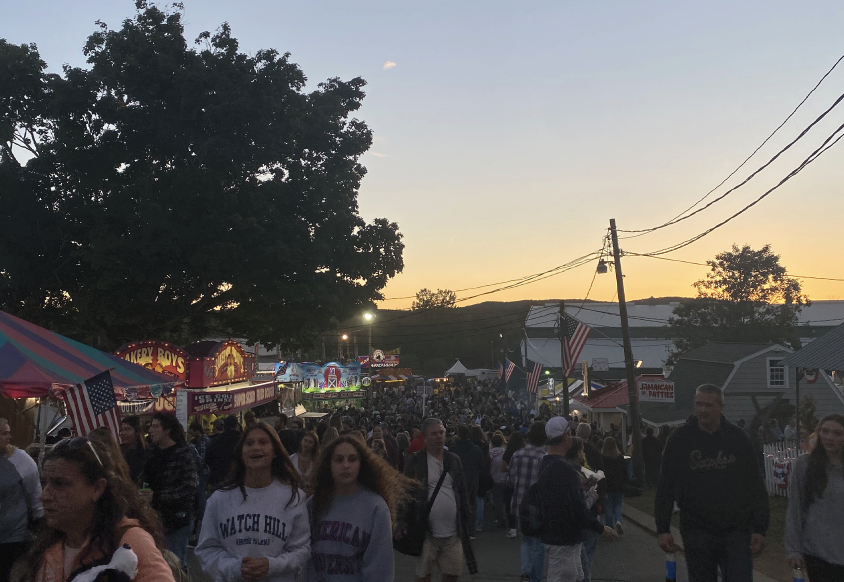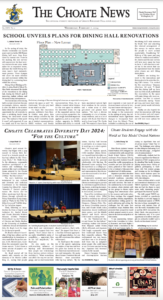
The Durham Fair offers a variety of activities and rides such as its flagship ferris wheel.

From hot dogs to cider doughnuts, students enjoy the diverse range of tasty foods at the fair.
On the final Friday of every September, all students in Durham, Connecticut, are given the day off from school to attend the historic Durham Fair. Since 1916, Durham has hosted one of the country’s largest annual agricultural fairs. This year, 162,400 people were in attendance.
Over its 100 years of operation, the fair has grown by 40 acres in size, three days in length, and hundreds of thousands in budget and profit. The first fair charged 25 cents per ticket and attracted 2,000 people. Today, the fair can draw up to 200,000 attendees, each paying $15 dollars for entry to enjoy over 10,000 agricultural exhibits, carnival rides, fair food, a monster truck rally, and live performances from both local bands and world-renowned celebrities.
This four-day extravaganza is unlike any other fair seen across the U.S. It is 100% volunteer run (this includes the executive team), and while the fair is technically nonprofit, income is an important factor in enabling its operation. Treasurer Mr. Leonard Baginski explained, “We are different from some fairs — the profit is not the motive, but the reality is, we need the money to survive too.”
The fair typically brings in $400,000-$500,000 each year and invests a large handful of this revenue toward improving the town and the lives of its people. Profit has been used to make repairs to the Durham Town Hall, renovate the public library, and grant up to $25,000 each year in academic scholarships. Additionally, there were over 27 nonprofit booths within the fair that served as their own fundraiser. Head of Marketing Ms. Debbie Huscher explained, “This year, Memorial Middle School, which is a fourth-and fifth-grade school, did a bounce obstacle course … and they profited $10,000.”
The organization and execution of such a large-scale event requires a large team of executives and diligent yearlong planning. When asked about the extent of their preparation work, Mr. Baginski responded, “We never stop.” The team holds their executive meeting on the first Wednesday of every month and their directors meeting on the second Wednesday of every month.
In addition to marketing, Ms. Huscher also oversees vendors, entertainment, and public relations for the fair. She explained that this year’s budget was very limited, around $50,000, which is 30% less than previous years.
For the most part, the fair itself produces the income needed to keep it up and running; however, the committee rents out their properties to raise additional funds. “We are pretty low on donations,” Mr. Baginski explained. “Our buildings are used in the winter to store boats and RV’s and some classic cars. We also own some rental property, three houses, and a store building on Main Street.”
Since 1916, there have been only five years when the fair did not run: in 1938 due to a hurricane, 1942-1944 during World War II, and in 2020 due to the pandemic. Contrary to popular opinion, Covid-19 greatly benefited the fair financially. “Our financial [situation] was positive because we had the income from winter properties, and no fair to pay for … It left us pretty neat,” said Mr. Baginski.
According to Head of Student Activities Ms. Alex Long, shuttles to the Durham Fair have been provided for Choate students since 2008. In previous years, more students could be shuttled; however, due to a lack of chaperones available, this year allowed for fewer than normal. “We had 45 students sign up with 75 students on the waitlist,” Ms. Long explained. 2022 was the first year that Choate’s Student Activities Office sponsored free tickets. “We feel that if the SAC (Student Activities Center) is sponsoring a trip, it should be free,” she said.
The bulk of students enjoyed the food and the rides the most. Cider doughnuts, doughboys, slushies, fries, and mini chocolate chip cookies were among the favorites. Yet, most students shared two common frustrations with the fair: long lines and high prices.
Jeremiah Olubowale ’25’s main criticism concerned the extensive and unmoving lines for the various rides. “If you actually waited in line, you wouldn’t get to go on the ride because a lot of people were cutting, so the only way to get on the rides in a timely manner was to cut,” he explained.
Students also criticized the large sum of money that the fair elicited from its attendees. “It was very, very expensive,” said Olubowale. Choate paid for the $15 entrance fee, but the rides, games, and food all required additional payments. Zoe Dieringer ’25 felt that the students were getting “scammed out of your money,” and although she “still thoroughly enjoys them [fairs],” they are designed to bring in revenue.
Though it may be a bit pricey and slightly overcrowded, the fair continues to excite the community and foster connections and great fun. Candace Beverly ’25 highlighted how special the fair felt for her because it marked a return to normalcy after years of hardships. “For me? Durham fair: 10 out of 10.”




